Adventure
AJANTA
-John Eickert
Sometimes, an item, a shirt, a blanket, a favorite pair of sandals, is misplaced and then forgotten. Time entwines with the conspiracy. One day, the item reappears and the associated joy begins anew. A long time ago, I’m
not sure when, I lost track of a favorite blanket, it was checked orange, yellow, red, and black. Last week I opened a drawer in an old desk and there the blanket lay, folded neat. I have no idea how that blanket got in that drawer. It was a warm reunion.
If one draws a line directly south from Delhi, just across the border from Madhya Pradesh into Maharashtra, a bus ride from Mumbai are the once lost caves of Ajanta. As might be guessed, a group of British army officers
were hunting tigers in late 1819 and they unwitting stumbled onto one of the caves. The caves at Ajanta, there are 27, are older than those at Ellora. Buddhists, Hinayana and then Mahayana used the caves and their utilization ended with the rise of Hindu and
Islam in India. Laborers gouged out the Deccan lava before 200 BC to form the caves. Abandoned sometime in the 7th century and then swallowed by the jungle, the caves forgotten until opened again. The champion of their cleaning and restoration was
James Fergusson who worked for the East India Company. The new history of these began then in 1843 and today is an astonishing tourist destination. There are interesting paintings and carved, pillared halls. The painting technique used at Ajanta is Tempura
technique. The rock surface is prepared and then stained, and finally burnished to complete the masterpiece. The color pigments came from local plants. It is a distinctive way to spend an afternoon. There is also a curse.
Numerous attempts, beginning with the British, to copy the paintings for further study in offsite locations failed. Fire or foolish handling destroyed the copies, some of which had taken years to produce. Photography is
not allowed in the caves for fear the light may destroy what remains. However, photos purchased in the gift shop, show detail. Archivists working for the government of India produced the photos and post cards. I purchased many when I visited there, but on
arriving back in Mumbai, the photos were gone. The curse had struck again. I wonder where they will turn up.
There are also caves at Aurangabad, Rauza, and Ellora. Ajanta is further and requires it’s own day. Ellora caves are the most extensive and complex and they were never lost. I have not been to Aurangabad caves or Rauza,
but someday, if there is ever enough time; and there never is, I will go there as well. I am sure all are worth the time.
As I sit at my desk and type these words, my mind is spinning with the news of deplorable acts of terrorism and worldwide unrest. Perhaps, if we are lucky the motive for these acts could be lost and forgotten. If
so, let us hope no one finds it.
--------------------------------------------------------------------------
P.S: Sometime in 1999, I visited Ajanta. Though flash photography was not allowed video
cameras were allowed in Ellora and some parts of Ajanta . One day I would like to complete a short documentary about the wonderful experience we had at Ajanta and Ellora. In the meantime, I have put together a few clips at the following link
http://www.youtube.com/watch?v=7D_EIJjaGgc
-Dr. Susan Sharma
|
Amazing Facts About Wildlife
Consider the lilies of the field….
Not Solomon, in all his glory, was arrayed as one of these
Flowers and pollinators
-S.Ananthanarayanan
Colour, scent, nectar, warmth, they all play a role in bringing pollinators to flowers, says S.Ananthanarayanan.
August is the month that brings tourists in to the ‘Valley of flowers’ a breathtaking sanctuary for flora in Uttaranchal. The route is to reach Rishikesh, take a bus to
Joshimath and then to trek to Ghangria, which is just at the sanctuary. And once there, Hemkund, Auli and the hot springs at Badrinath are within a day’s reach.
The flowering business
Unlike insects and mammals, which can move and seek mates, plants need to use external agencies to make reproduction possible. And the plant that can do this with the
most genetic variety and efficiency is the best survivor.
Reproduction in plants takes place when the pollen, the male part, of one plant comes into contact with the stigma, which leads to the ovary, of another plant.
Evolution, then, has created the array of flower varieties, to attract insects to visit the plant with pollen from other plants and then to carry pollen away to yet others.
And so, the palette of infinite colours, the myriad perfumes and the nectar, as reward for the insect for having responded to the colour and smell. In fact, it is the
nectar for which the insect comes – the colour and perfume are to signal and advertise!
In fact, there is a class of plants that actually generate their own heat, so that strong odours, of rotting flesh, emanate. This
attracts insects that carry pollen from a previous attraction to the same smell. The Dead Horse Arum, of Corsica, is perhaps the best
known. This plant generates more heat than any other and exudes a strong odor of dead horses’ meat. Blowflies are attracted to the Arum and they bring the pollen for the
female parts of the flower, deep within, which are the first to mature. Spines and tendrils at the entrance trap the fly for many hours, till the male parts of the flower also mature.
The trap is then released and the flies go forth, carrying pollen from the male parts.
.
Other economies
Such straight deception apart, most flowers are heat collectors and insects come to flowers not just for nectar but also for a warm place where it is easier to maintain
body temperature. Here, a recent study has shown, the colour of the flower signals the flower that provides not just the most nutrition but also greater warmth. Lars Chittka and colleagues at the University of London have shown that bumblebees prefer to visit
warmer flowers and that they use colour to predict floral temperature before landing.
The experiment was first to see if the bumblebees in fact preferred warmer nectar. A nest of the insects was placed in an arena with different samples of sucrose, some
warmer than others. It was found that the insects consistently went more often for the warmer nutrient, the preference being marked when the temperature difference was 4 C or more.
Next, to see if the bees used colour as an identifier of warmer nectar, sucrose was placed in artificial flowers of different colours – 4 pink flowers at 20 C and f purple flowers at 28 C. There was a marked higher frequency
of feeding from the purple flowers. In a control group, where the flowers were all at the same temperature, there was no preference, which shows that the it was not the colour that the bees preferred, it was the higher temperature that the colours indicated.
Some plants, then, provide warmth as a major attraction and can hold pollinators for long periods, even without nutritional reward. But others may have evolved to reproduce more efficiently by offering a quick and tasty
snack but no heat, so that the pollinator speeds on its way!
[The writer can be contacted at simplescience@gmail.com]
|
Common Birds of India
White Ibis ( Threskiornis aethiopia )
-RagooRao
This month I have chosen the White Ibis for the Bird of the Month because right now they are all busy in parenting activities. Visitors to
bird sanctuaries particularly riverine sanctuaries or marsh land sanctuaries are very likely to have seen these birds.
Come June and right through August a visit to the marsh lands or riverside bird sanctuaries, the graceful, white bird with an arching slender
black beak and head about the size of a well fed domestic chicken only much taller because of slender long legs is unmistakably the White Ibis.
In this season they are likely to have a little slate grey on their shoulders and a little downy plumes ornamentally placed around their necks as a breeding suit. Both sexes similar.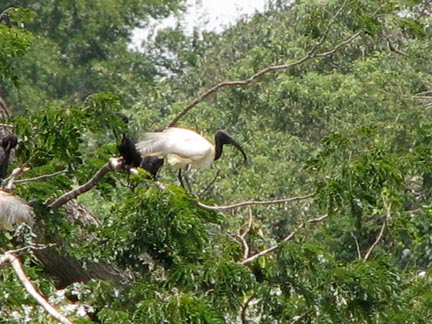
Their distribution is through out the country and they are locally migratory. They are found usually foraging on open fields, always in pairs
or flocks, paddy fields and in marshy areas. They dig their heads deep into the water probing the silt below for crustaceans and other mollusks. They are normally silent and very wary and take off with efforted wing flaps when intruded.
Their silence is owing to their lack of true voice producing mechanisms in their anatomical features. They are only heard to give out harsh grunts in their nesting colonies and squabbling with their neighbors like the cormorants, egrets, spoonbills and
open billed storks. It appears like a squabbling neighborhood, only thing is each nesting pair is asserting their territories.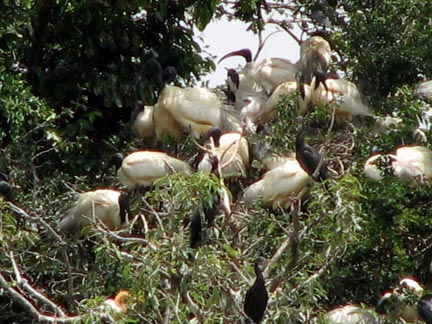
A lone ibis perched high in their nesting colonies is a striking study of their profile. The nests are built with twigs and lined with feathers.
But they choose trees which are very close to water bodies or the ones that are growing in small islands inside the water bodies. They nest in urban lakes or just nearby villages and they share these colonies with other birds.
Normally a clutch has two to four greenish or bluish white with occasional yellowish spots. Both parents do all the domestic chores.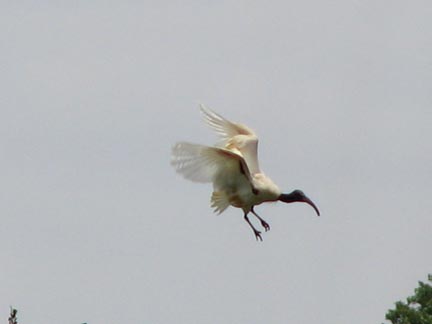
An Ibis's flight is not much of a thing compared to other birds but they have one of the most graceful landings which only a few birds have.
When an Ibis Landing is watched it looks like a perfectly designed, well synchronized deliberate maneuver with their long legs outstretched, like the undercarriage of an aircraft, wings flapping in slow motion and finally making a perfect landing.
A very graceful, harmless bird is a thing to be admired, and thank Nature for giving us such lovely creatures to share the Planet with us.
|
Eco-travel
On a trail of the Ganga -
PART 1II
-Saraswati Kavula
 I moved on from Chirbasa towards Bhojbasa which was another 5 kilometres away. On the way, there were numerous landslides. We had to look out before
we crossed the line of the land slides. There was a constant danger of the rocks tumbling down. Anyway, me and a couple of men from Delhi who too were on the mules, moved on cautiously, each animal was led by a driver –local youth who get paid, Rs.50 for taking
us up and then back a total of 36 kilometres, walking and controlling the animal all the way, though the actual amount paid to the owner of the animal was 825. Out of which, Rs.250 was paid to the local governing body and 25 rupees as entry fee to the national
park and fifty rupees for the boy’s food. So, out of five hundred rupees, what the boy gets for his work was only Rs.50. I asked him “how much does he walk in a day”, “I can walk up to 80 kms.” My mule driver told me that the landslides have been increasing
over the years. I moved on from Chirbasa towards Bhojbasa which was another 5 kilometres away. On the way, there were numerous landslides. We had to look out before
we crossed the line of the land slides. There was a constant danger of the rocks tumbling down. Anyway, me and a couple of men from Delhi who too were on the mules, moved on cautiously, each animal was led by a driver –local youth who get paid, Rs.50 for taking
us up and then back a total of 36 kilometres, walking and controlling the animal all the way, though the actual amount paid to the owner of the animal was 825. Out of which, Rs.250 was paid to the local governing body and 25 rupees as entry fee to the national
park and fifty rupees for the boy’s food. So, out of five hundred rupees, what the boy gets for his work was only Rs.50. I asked him “how much does he walk in a day”, “I can walk up to 80 kms.” My mule driver told me that the landslides have been increasing
over the years.
With some difficulty we reached Bhojbasa, which had numerous Dhabas, and down in the valley, there were a couple of hotels too, one was an ashram with
basic dormitory facilities and another was the Garhwal Mandal Vikas Nigam’s Tourist Bunglow. From here one could see the surrounding area all the way up to the Gomukh area. My driver pointed out, “Just beyond that mountain is Gomukh” I looked out, did not
find any traces of a glacier. It was another four kilometres from Bhojbasa. After a short tea break at one of the dhabas, we set out once again. We reached the next stop – another Dhaba close to Gomukh, my driver told me to get down and said, “You have to
walk up about some distance to reach the Glacier”. I looked around; the entire place was like a dry, cold, desert, just muddy mountains, and rocks, no signs of any snow. The Ganges was flowing on one side. We found people returning from the other side. With
the difficulty of a still back, I managed to climb up and down the slippery rocks, (since it was raining) and one kept walking with no sign of the glacier. One man was returning from the other side, I asked him, “How far is the glacier?” He replied, “Look
over there, another one kilometre, you find it.” I looked in the direction where he pointed; I could only see a cave in a far distance with some ice in it. “That one?” “Yes there, you can see some people taking a bath in the river near the cave? The same place?”
he replied. ‘Is that all there is?” “Yes”. I must say, I was terribly disappointed. 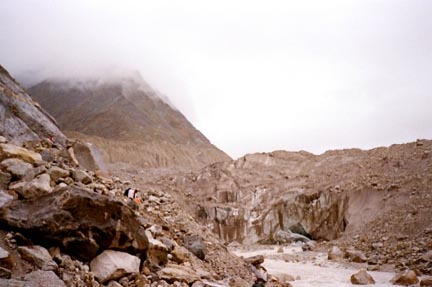
In fact, I had a better view of the mountain snows when I had been on a trek to the Sarakhund Pass in Himachal. That was ten years ago, one cannot say
what is the state of affairs in that place now. So, I decided to return and made my way back on the mule, after a short break for lunch at the Dhaba near Gomukh. At Chirbasa once again we stopped for some tea. My Mule mates from Delhi too felt that they were
disappointed with the Glacier. They did go up to the cave and took a dip in the freezing cold Ganga’s water, but were disappointed with the view of a barren deserted area.
Over tea, we discussed my conversation with the trekkers, to which they commented, “Well, it is thanks to these nature loving, adventure seekers, that Everest has become a trash can today”.
All the way, I found lots of Hindu Sadhus walking up and down the path to the Glacier. At least, they were being more eco-friendly – most of them
carried water in their brass pots, and carried their minimum rations as well. I was surprised, most of them walked bare foot and had only their lungi and kurta covering their bodies in that freezing cold. I heard that many of them stay back in the numerous
caves that dot the mountains and may walk up to Tapovan and Nandanvan in the same way. Their religious beliefs apart, at least they were not demanding on the local resources like the touring pilgrims and trekkers.
I was back at Gangotri the same evening. The next day morning, I was going through the market, and stopped at a place to make a long distance call. On
the table there were some photographs of people crossing the glacier near Tapovan and the Gomukh Glacier itself in all its splendour. I told the man of my experience, and said that I was disappointed. “Yes, they must ban trekking in this area, in fact; no
one should be allowed to go beyond Gangotri. People are constantly walking on the glacier and it is affecting it very much”. I asked him if he had been there, “yes, I had gone on a couple of mountaineering trips to Tapovan and beyond to Nandanvan, as a guide
with mountaineering groups that arrive here. The Nehru Institute of Mountaineering organise many training camps in this area, every summer”. I was a bit taken aback, I asked him, “well, you had been on those glaciers yourself, but now you say that others should
be stopped from entering the area!’ He shifted a bit uncomfortably, “well, yes, but now, the glacier is getting destroyed, so it must be stopped!’
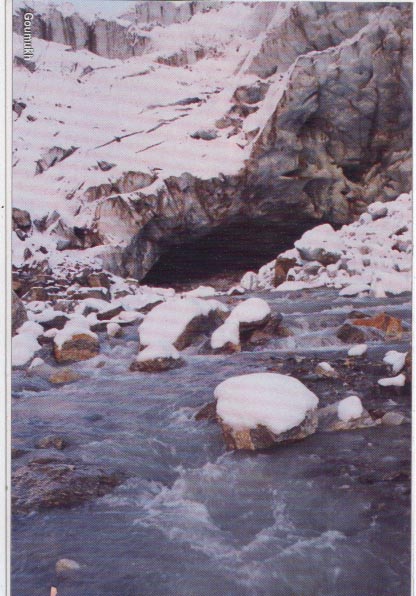 I asked him if I could borrow the photographs, he said, ‘you can, if you want more, you can buy them from the shop opposite, where we have
kept these pictures for sale, most of them have been taken by me’. I thanked him and went on to purchase a couple of photos of the Gomukh and the trekking parties. From the photo shop I walked up to the Gauri Kund, a place where the Ganga falls into a pool
with great force. I had to cross an ashram to go there. One of the sadhus from the Ashram, Gyanand maharaj, told me to go across and watch the waterfalls from their compound wall. As I was peeping over the wall and listening to the roar of the water, I found
trash lining the walls of the valley just above the water. Gyanji was standing next to me speaking to some visitor, “This time the sound of the water is very less. There was not much snow this year. But normally, when you sit inside the ashram and concentrate
on the sound of the water, you can easily slip into a state of meditation and bliss” I remarked to him, “I am surprised that while people come here all the way to pray to Ganga, they don’t think twice before dumping trash that pollutes the river”. Gyanji replied,
“Well, that is what Sanatana Dharma teaches, to live in harmony with nature, there is nothing more to it, unfortunately people are stuck in outwardly rituals’. I asked him if I could borrow the photographs, he said, ‘you can, if you want more, you can buy them from the shop opposite, where we have
kept these pictures for sale, most of them have been taken by me’. I thanked him and went on to purchase a couple of photos of the Gomukh and the trekking parties. From the photo shop I walked up to the Gauri Kund, a place where the Ganga falls into a pool
with great force. I had to cross an ashram to go there. One of the sadhus from the Ashram, Gyanand maharaj, told me to go across and watch the waterfalls from their compound wall. As I was peeping over the wall and listening to the roar of the water, I found
trash lining the walls of the valley just above the water. Gyanji was standing next to me speaking to some visitor, “This time the sound of the water is very less. There was not much snow this year. But normally, when you sit inside the ashram and concentrate
on the sound of the water, you can easily slip into a state of meditation and bliss” I remarked to him, “I am surprised that while people come here all the way to pray to Ganga, they don’t think twice before dumping trash that pollutes the river”. Gyanji replied,
“Well, that is what Sanatana Dharma teaches, to live in harmony with nature, there is nothing more to it, unfortunately people are stuck in outwardly rituals’.
( Photographs: 1.Way to Bhojwasa and 2.Gomukh as it is today by Saraswati Kavula.
3. Gomukh with snow from postcard)
-To be continued
|
News and Views
News and Views
Log in to
BLOG
Click on “Add blog”, log in with your email id and password and start writing. Use our simple ‘HTML’ editor to edit what you have written and click ‘submit’ to upload.
Bio Diversity, Books, Climate Change and Global Warming, Community Reserves, E-governance for conservation, Eco-tour, Engineers and Environment, Environment Awareness, Environmental Education, IWC E-zine, Film Reviews, General, Interlinking of rivers, nature/wildlife
films, Tiger Task Force Report, Tribal Bill-How will it affect our forests, Wildlife, Wildlife, Forest laws, Any other…………
You are invited to write on any of the areas covered by the above themes. If a topic of your interest is missing, tell us and we could add that too.
(TIP: Write your piece in the notepad first and then cut and paste it on to the blog pad; This will save
time and avoid loss of data in the event you are logged out due to some reason.)
Do not worry about your ability to write; at IWC, what you say matters, not how you say it, or who you are.
Your audience is the large IWC membership PLUS all those who have opted to read anything written on similar topics online.
TEAM IWC
|
Story Of The Month
SLIMY SOULS
-Shivani Thakur
The Western Ghats of India are as rich in bio diversity as the Amazonian basin.
The variety of flora and fauna is as exotic as those found elsewhere in the tropical rainforests of the world.
Of all the animals found in the ghats; amphibians are rarely given a thought. They are looked down by us and generally referred as icky, slimy creatures not worth the mention. Their existence or lack of it is hardly a concern for us.
Yet, an environmental researcher would always take interest in their population, how they sustain themselves.
Amphibians form three types of orders namely Caecilians, frogs and toads, and salamanders and newts.
The Ghats are considered a hot spot of amphibian diversity. S.D.Biju,
a conservation biologist at the Tropical Garden Research Institute at Palode, Kerala,
along with Franky Bossuyt ,an evolutionary geneticist at the Brussels Free University in Belgium have recently made a “once-in-a century “ find reported in the Nature magazine.
S.D.Biju discovered a three- inch long purple snub- nosed frog. This frog is not only a new species but also a new family of frogs altogether. Its internal anatomy and DNA sequence, done by Franky Bossuyt, shows it belongs to a
species that existed in the age the dinosaurs. Its closest relatives now live in Seychelles, 3000 km south of the Indian peninsula, providing another piece of evidence in the theory of continent drift
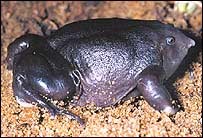 S.Blair Hedges, in the section of news &views of
Nature magazine describes it as a ‘once in a century’
find because only 29 families of frogs are known, encompassing the approximately 4,800 species. The last discovery of any species of frogs belonging to a new family was in 1926.
Earliest by mid 1800s, most of these families had been named. Dr.Biju, a botanist, is an authority on frogs.
His interest in frogs was sparked by the many odd specimens of frogs he encountered during his botanical surveys in the Western Ghats forests.
His recent synopsis of the fog fauna of the Western Ghats mentions four new genera and about 115 new species awaiting scientific description. This purple colored frog, Nasikabatrachus sahyadrenis, maybe rare but is widely distributed in forests of Western
Ghats and plantations of Kerala and Tamil Nadu.
S.Blair Hedges, in the section of news &views of
Nature magazine describes it as a ‘once in a century’
find because only 29 families of frogs are known, encompassing the approximately 4,800 species. The last discovery of any species of frogs belonging to a new family was in 1926.
Earliest by mid 1800s, most of these families had been named. Dr.Biju, a botanist, is an authority on frogs.
His interest in frogs was sparked by the many odd specimens of frogs he encountered during his botanical surveys in the Western Ghats forests.
His recent synopsis of the fog fauna of the Western Ghats mentions four new genera and about 115 new species awaiting scientific description. This purple colored frog, Nasikabatrachus sahyadrenis, maybe rare but is widely distributed in forests of Western
Ghats and plantations of Kerala and Tamil Nadu.
Another amphibian variety has been discovered in the Ghats. According to
Current Science the number of species of caecilian (limbless) amphibians is growing rapidly. There has been a remarkable increase of 57 per cent in caecilian amphibian diversity over past eight years. Most of them have been found to inhabit gardens
or plantations yet gone unnoticed by the scientists. The intrinsic biology of caecilian makes their study challenging. The Indian caecilian amphibian burrows the soil and special digging effort is needed to bring it out. These findings suggest a need for more
biotic surveys of this region and application of modern techniques such as molecular analysis to aid the search for new amphibian species. More so because they are the best indicators overall of environmental health. Their porous skin allow for water transpiration
and movement of chemicals. Amphibians drink and breathe through their skins so if anything happens to their skin it starts affecting them. If the third of world’s amphibian species is facing extinction it is because of loss of habitat, to pollution, climate
changes and increasing competition with humans. Their deaths could be an indicator of the poor state of our environment.
( Photo courtesy: BBC News)
|